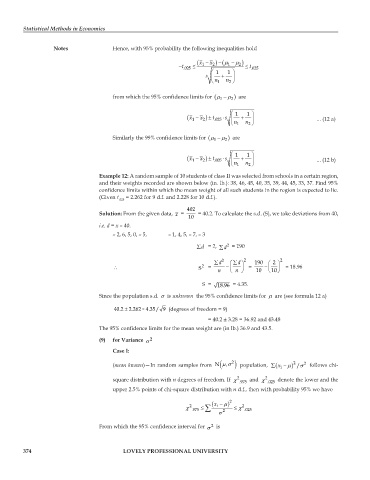Page 379 - DECO504_STATISTICAL_METHODS_IN_ECONOMICS_ENGLISH
P. 379
Statistical Methods in Economics
Notes Hence, with 95% probability the following inequalities hold
− .025 ≤t ( 1 − x 2 ) (μ − x 1 μ − 2 ) ≤ t .025
s ⎛ ⎜ + 1 ⎞ 1 ⎟
⎝ n n 2 ⎠ 1
from which the 95% confidence limits for ( 1 μ − 2 )μ are
( − x 2 ) 1 ± x ⋅t s ⎛ + ⎜ .025 1 ⎞ 1 ⎟ ... (12 a)
⎝ n n 2 ⎠ 1
Similarly the 99% confidence limits for ( 1 μ − 2 )μ are
( − x 2 ) 1 ± x ⋅t s ⎛ + ⎜ .005 1 ⎞ 1 ⎟ ... (12 b)
⎝ n n 2 ⎠ 1
Example 12: A random sample of 10 students of class II was selected from schools in a certain region,
and their weights recorded are shown below (in. lb.): 38, 46, 45, 40, 35, 39, 44, 45, 33, 37. Find 95%
confidence limits within which the mean weight of all such students in the region is expected to lie.
(Given t = 2.262 for 9 d.f. and 2.228 for 10 d.f.).
.025
402
Solution: From the given data, x = = 40.2. To calculate the s.d. (S), we take deviations from 40,
10
i.e. d = x – 40.
– 2, 6, 5, 0, – 5, – 1, 4, 5, – 7, – 3
∑d = 2, ∑d 2 = 190
∑ 2 ⎛ ∑d d ⎞ 2 190 ⎛ ⎞ 2 2
∴ S 2 = − ⎜ ⎟ = − ⎜ ⎟ = 18.96
⎝ n ⎠ n ⎝ 10 ⎠ 10
S= 18.96 = 4.35.
Since the population s.d. σ is unknown the 95% confidence limits for μ are (see formula 12 a)
40.2 ± 2.262 × 4.35/ 9 (degrees of freedom = 9)
= 40.2 ± 3.28 = 36.92 and 43.48
The 95% confidence limits for the mean weight are (in lb.) 36.9 and 43.5.
(9) for Variance σ 2
Case I:
2
(mean known)—In random samples from ( μ σN , 2 ) population, ( ∑ − x μ ) i 2 / σ follows chi-
square distribution with n degrees of freedom. If χ 2 .975 and χ 2 .025 denote the lower and the
upper 2.5% points of chi-square distribution with n d.f., then with probability 95% we have
χ 2 .975 ≤ ∑ ( x − μ ) i 2 ≤ χ 2 .025
σ 2
From which the 95% confidence interval for σ 2 is
374 LOVELY PROFESSIONAL UNIVERSITY

